Relationship Between Social Inclusion, Exclusion, and Self-Esteem
VerifiedAdded on 2020/02/19
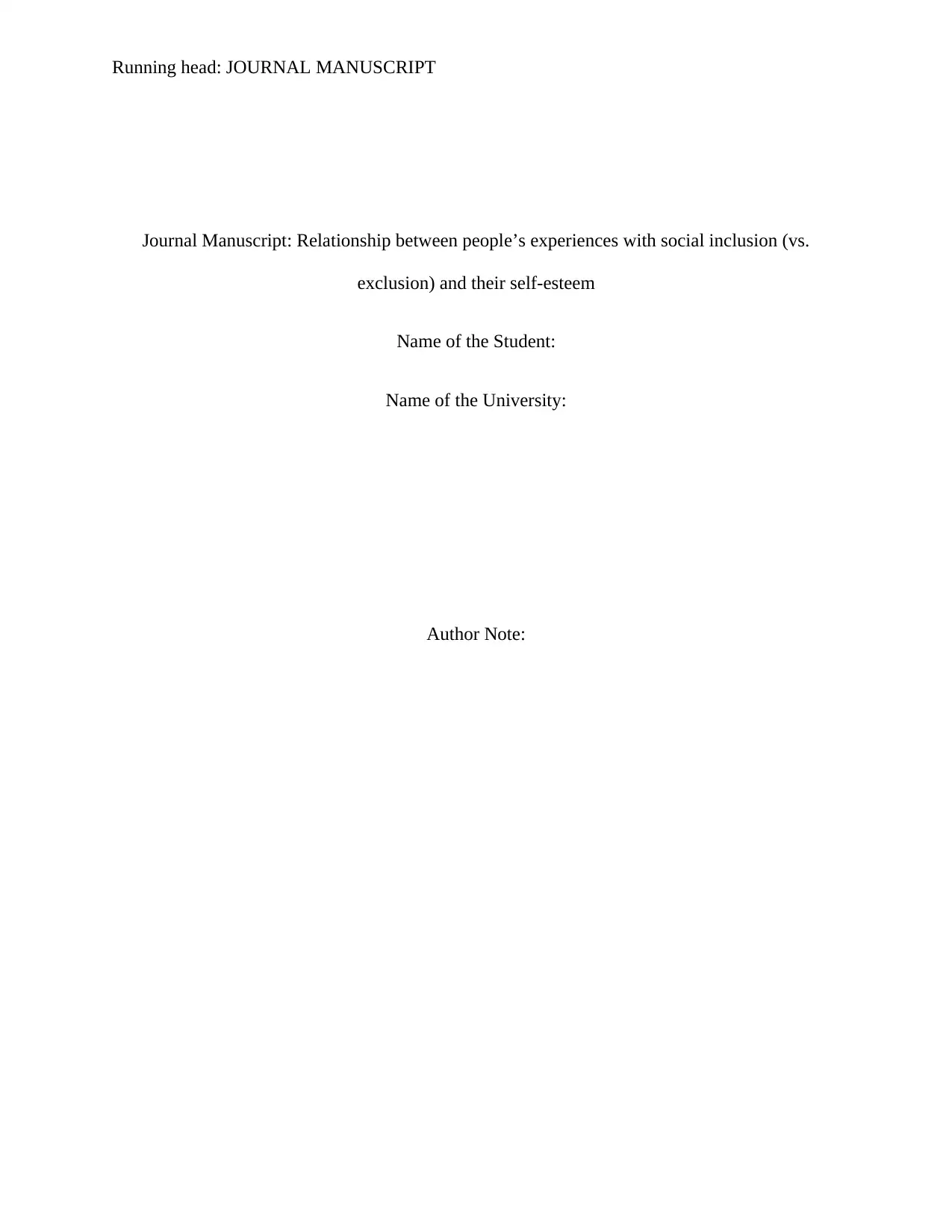
Journal Manuscript: Relationship between people’s experiences with social inclusion (vs.
exclusion) and their self-esteem
Name of the Student:
Name of the University:
Author Note:
Paraphrase This Document

JOURNAL MANUSCRIPT
Abstract
Psychological studies have paid attention to the situations as applicable in case of ostracism and
neuroticism. With the technological advancement, the mental health concerns that are associated
with humans who are the end users of these services have garnered much interest. The emotional
volatility related to neuroticism has been attributed to a general level of anxiety. Moderating
effect of personality with respect to self-esteem or belongingness is also vital for measurement
and understanding situation. Therefore, this study will essentially focus on these aspects to
provide an insight on the chosen topic of investigation by virtue of referring to relevant studies
conducted in similar contexts.
Aim of the Study: The general aim of the study is to examine the relationship between people’s
experiences with social inclusion (vs. exclusion) and their self-esteem.
Sample Size: final sizes of the sample were 319
Results: With high inclusion, there is no significant difference in self esteemed, be it low or high
neuroticism. On the other hand low level of social inclusion, the self esteem varies depending on
the neuroticism.
General conclusion: There lie a significant relation between inclusion, self-esteem and
neuroticism.

JOURNAL MANUSCRIPT
Table of Contents
Abstract............................................................................................................................................1
Introduction......................................................................................................................................3
Aim of the Study..........................................................................................................................5
Hypotheses for the study.............................................................................................................6
Methodology....................................................................................................................................7
Participants of the Study..............................................................................................................7
The Design of the Study..............................................................................................................7
Materials needed for the Study....................................................................................................8
Procedure.....................................................................................................................................8
Results and Analysis......................................................................................................................10
Conclusion.....................................................................................................................................14
Discussion......................................................................................................................................15
Limitations.................................................................................................................................16
Future Implication.....................................................................................................................16
References......................................................................................................................................18
⊘ This is a preview!⊘
Do you want full access?
Subscribe today to unlock all pages.

Trusted by 1+ million students worldwide

JOURNAL MANUSCRIPT
Paraphrase This Document
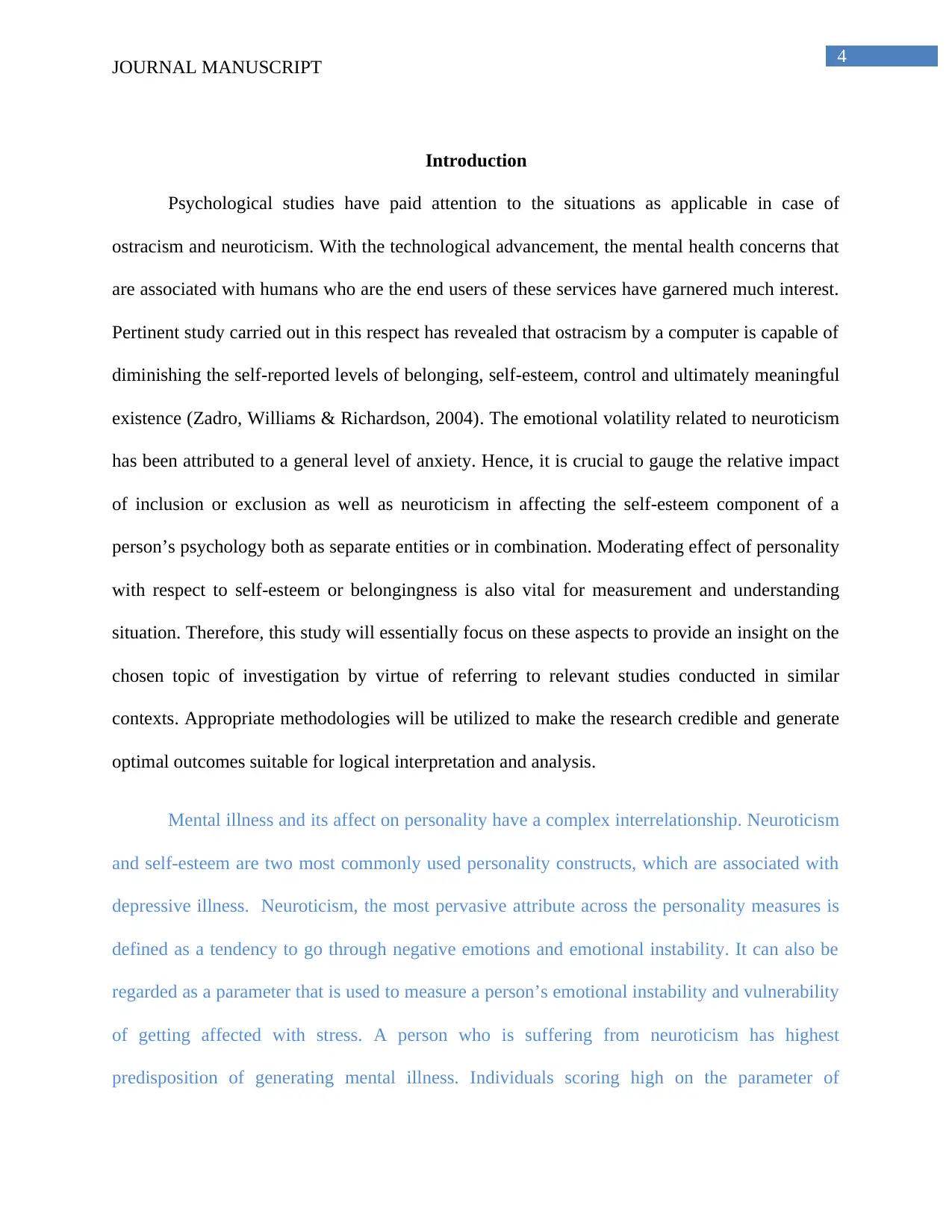
JOURNAL MANUSCRIPT
Introduction
Psychological studies have paid attention to the situations as applicable in case of
ostracism and neuroticism. With the technological advancement, the mental health concerns that
are associated with humans who are the end users of these services have garnered much interest.
Pertinent study carried out in this respect has revealed that ostracism by a computer is capable of
diminishing the self-reported levels of belonging, self-esteem, control and ultimately meaningful
existence (Zadro, Williams & Richardson, 2004). The emotional volatility related to neuroticism
has been attributed to a general level of anxiety. Hence, it is crucial to gauge the relative impact
of inclusion or exclusion as well as neuroticism in affecting the self-esteem component of a
person’s psychology both as separate entities or in combination. Moderating effect of personality
with respect to self-esteem or belongingness is also vital for measurement and understanding
situation. Therefore, this study will essentially focus on these aspects to provide an insight on the
chosen topic of investigation by virtue of referring to relevant studies conducted in similar
contexts. Appropriate methodologies will be utilized to make the research credible and generate
optimal outcomes suitable for logical interpretation and analysis.
Mental illness and its affect on personality have a complex interrelationship. Neuroticism
and self-esteem are two most commonly used personality constructs, which are associated with
depressive illness. Neuroticism, the most pervasive attribute across the personality measures is
defined as a tendency to go through negative emotions and emotional instability. It can also be
regarded as a parameter that is used to measure a person’s emotional instability and vulnerability
of getting affected with stress. A person who is suffering from neuroticism has highest
predisposition of generating mental illness. Individuals scoring high on the parameter of
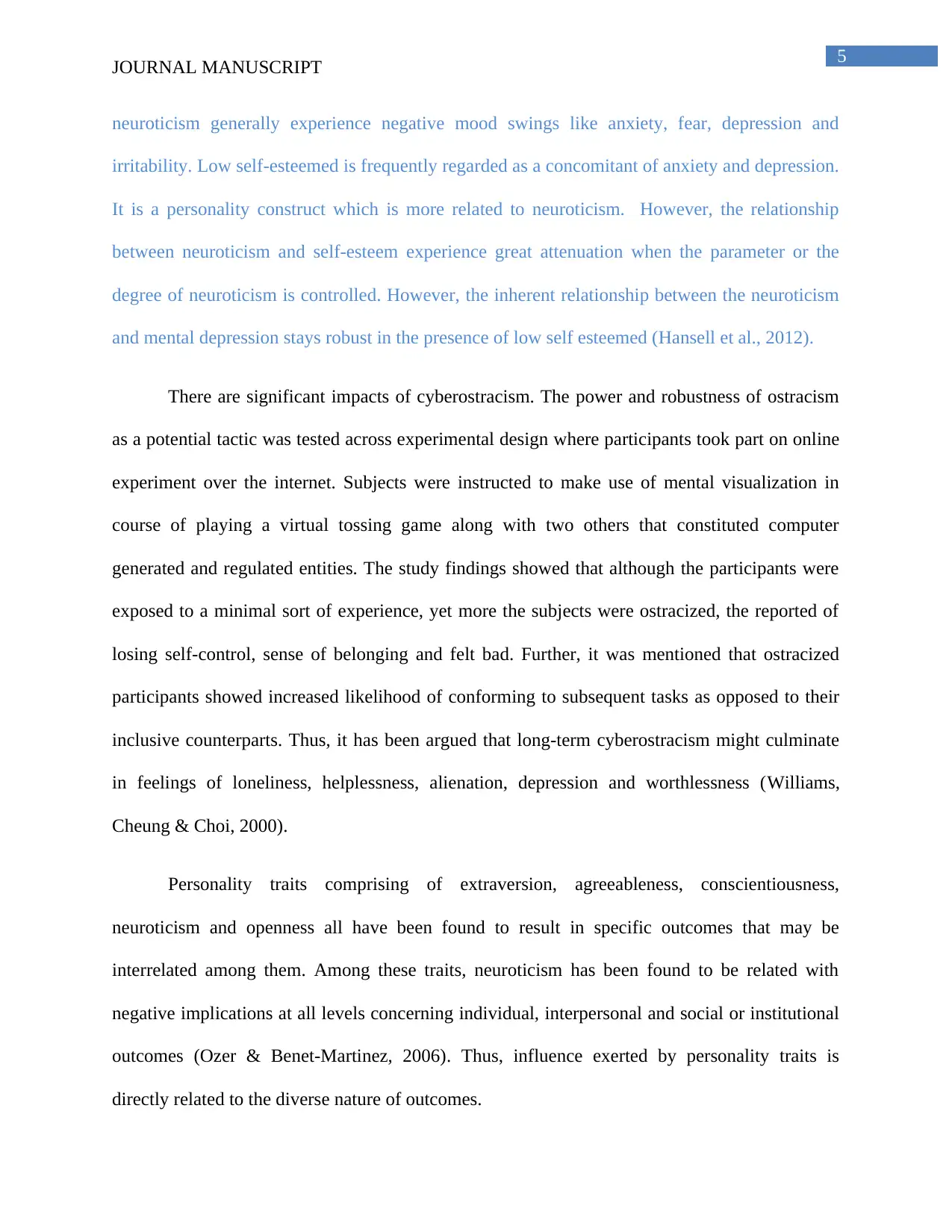
JOURNAL MANUSCRIPT
neuroticism generally experience negative mood swings like anxiety, fear, depression and
irritability. Low self-esteemed is frequently regarded as a concomitant of anxiety and depression.
It is a personality construct which is more related to neuroticism. However, the relationship
between neuroticism and self-esteem experience great attenuation when the parameter or the
degree of neuroticism is controlled. However, the inherent relationship between the neuroticism
and mental depression stays robust in the presence of low self esteemed (Hansell et al., 2012).
There are significant impacts of cyberostracism. The power and robustness of ostracism
as a potential tactic was tested across experimental design where participants took part on online
experiment over the internet. Subjects were instructed to make use of mental visualization in
course of playing a virtual tossing game along with two others that constituted computer
generated and regulated entities. The study findings showed that although the participants were
exposed to a minimal sort of experience, yet more the subjects were ostracized, the reported of
losing self-control, sense of belonging and felt bad. Further, it was mentioned that ostracized
participants showed increased likelihood of conforming to subsequent tasks as opposed to their
inclusive counterparts. Thus, it has been argued that long-term cyberostracism might culminate
in feelings of loneliness, helplessness, alienation, depression and worthlessness (Williams,
Cheung & Choi, 2000).
Personality traits comprising of extraversion, agreeableness, conscientiousness,
neuroticism and openness all have been found to result in specific outcomes that may be
interrelated among them. Among these traits, neuroticism has been found to be related with
negative implications at all levels concerning individual, interpersonal and social or institutional
outcomes (Ozer & Benet-Martinez, 2006). Thus, influence exerted by personality traits is
directly related to the diverse nature of outcomes.
⊘ This is a preview!⊘
Do you want full access?
Subscribe today to unlock all pages.

Trusted by 1+ million students worldwide
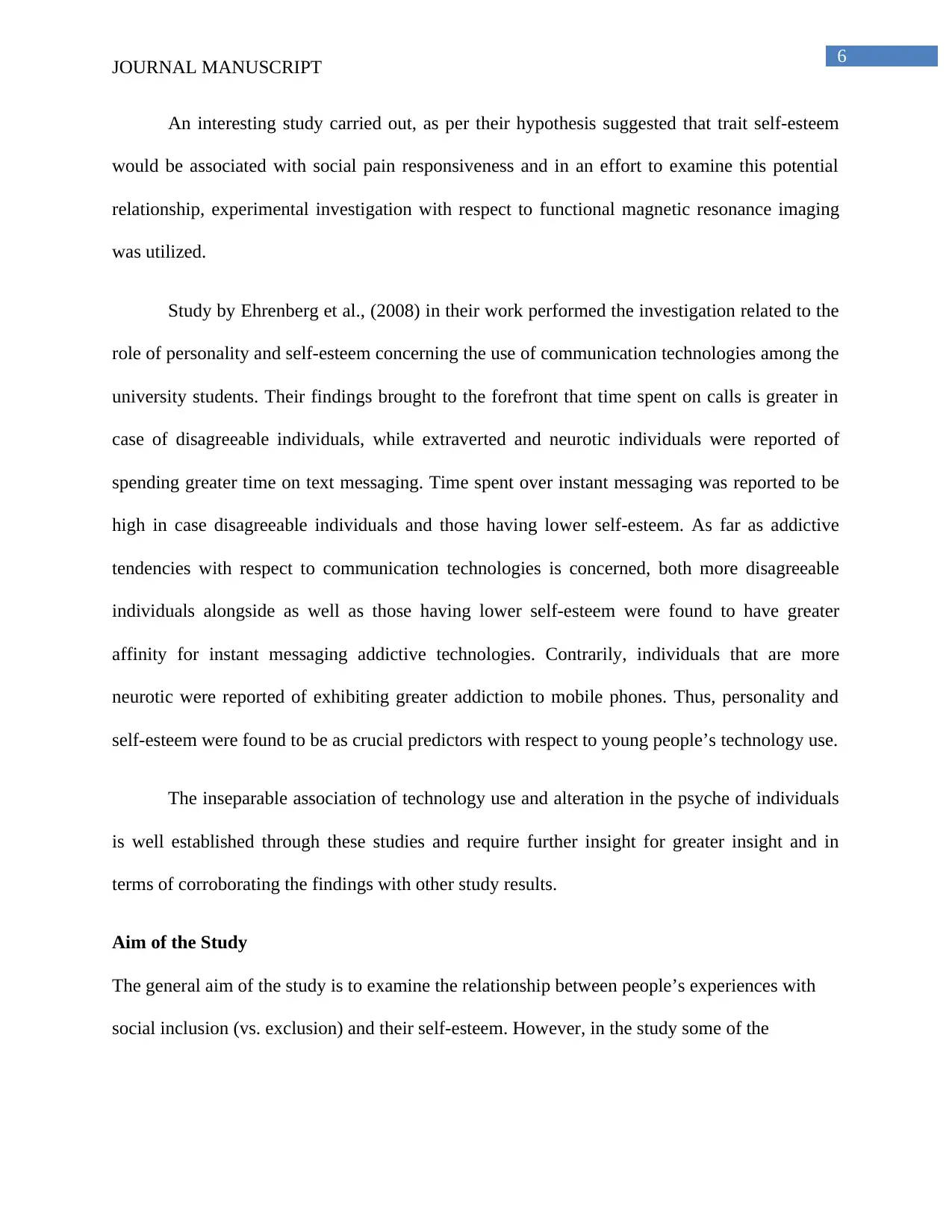
JOURNAL MANUSCRIPT
An interesting study carried out, as per their hypothesis suggested that trait self-esteem
would be associated with social pain responsiveness and in an effort to examine this potential
relationship, experimental investigation with respect to functional magnetic resonance imaging
was utilized.
Study by Ehrenberg et al., (2008) in their work performed the investigation related to the
role of personality and self-esteem concerning the use of communication technologies among the
university students. Their findings brought to the forefront that time spent on calls is greater in
case of disagreeable individuals, while extraverted and neurotic individuals were reported of
spending greater time on text messaging. Time spent over instant messaging was reported to be
high in case disagreeable individuals and those having lower self-esteem. As far as addictive
tendencies with respect to communication technologies is concerned, both more disagreeable
individuals alongside as well as those having lower self-esteem were found to have greater
affinity for instant messaging addictive technologies. Contrarily, individuals that are more
neurotic were reported of exhibiting greater addiction to mobile phones. Thus, personality and
self-esteem were found to be as crucial predictors with respect to young people’s technology use.
The inseparable association of technology use and alteration in the psyche of individuals
is well established through these studies and require further insight for greater insight and in
terms of corroborating the findings with other study results.
Aim of the Study
The general aim of the study is to examine the relationship between people’s experiences with
social inclusion (vs. exclusion) and their self-esteem. However, in the study some of the
Paraphrase This Document
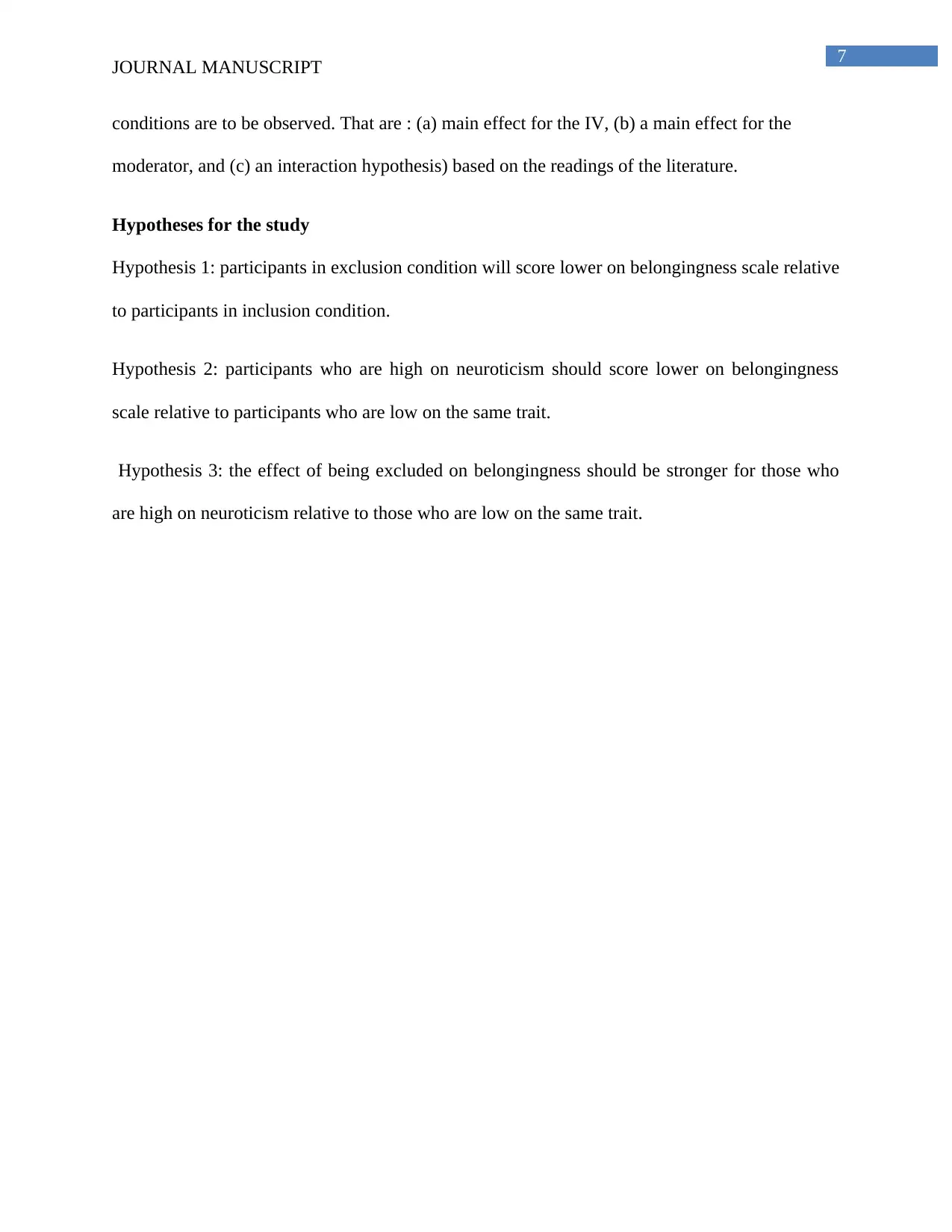
JOURNAL MANUSCRIPT
conditions are to be observed. That are : (a) main effect for the IV, (b) a main effect for the
moderator, and (c) an interaction hypothesis) based on the readings of the literature.
Hypotheses for the study
Hypothesis 1: participants in exclusion condition will score lower on belongingness scale relative
to participants in inclusion condition.
Hypothesis 2: participants who are high on neuroticism should score lower on belongingness
scale relative to participants who are low on the same trait.
Hypothesis 3: the effect of being excluded on belongingness should be stronger for those who
are high on neuroticism relative to those who are low on the same trait.
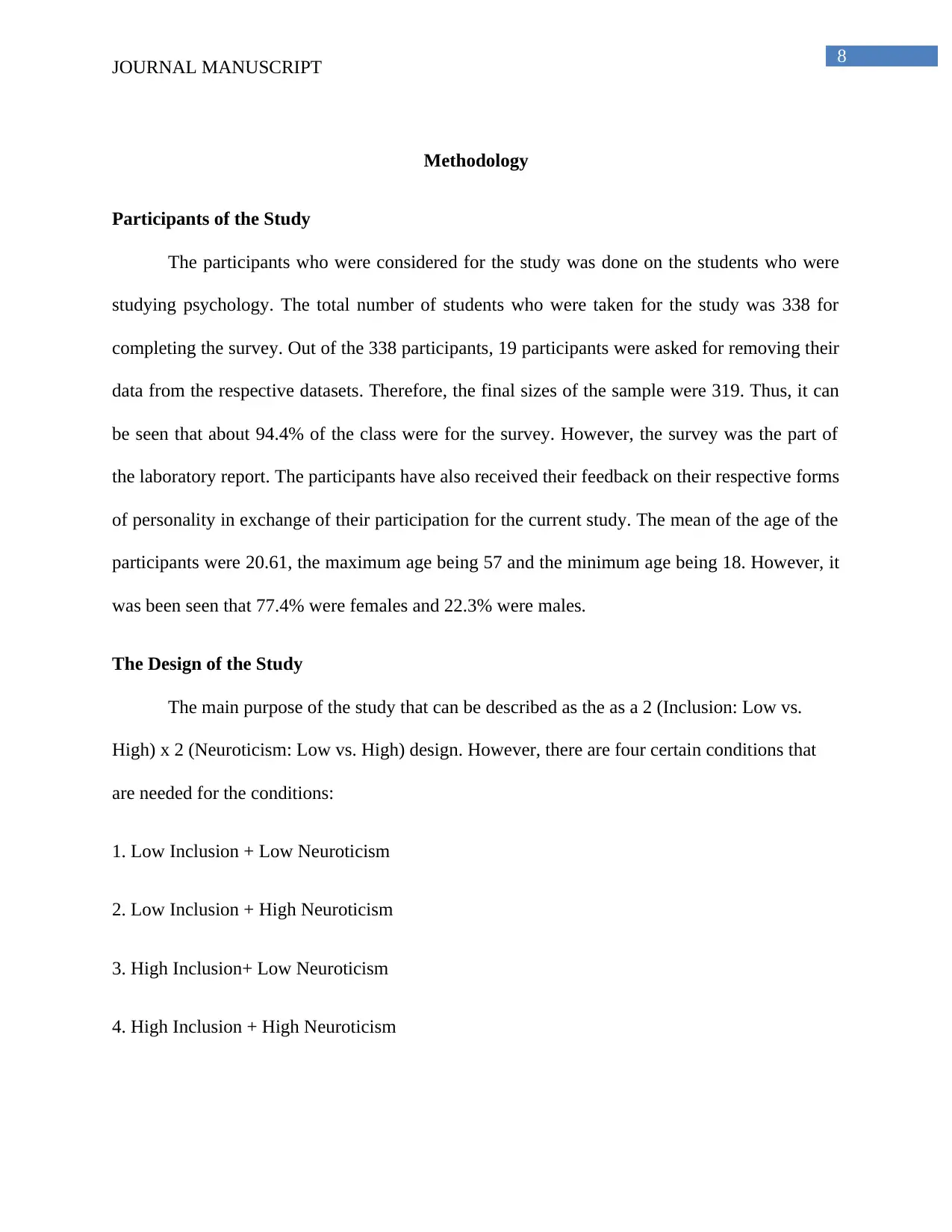
JOURNAL MANUSCRIPT
Methodology
Participants of the Study
The participants who were considered for the study was done on the students who were
studying psychology. The total number of students who were taken for the study was 338 for
completing the survey. Out of the 338 participants, 19 participants were asked for removing their
data from the respective datasets. Therefore, the final sizes of the sample were 319. Thus, it can
be seen that about 94.4% of the class were for the survey. However, the survey was the part of
the laboratory report. The participants have also received their feedback on their respective forms
of personality in exchange of their participation for the current study. The mean of the age of the
participants were 20.61, the maximum age being 57 and the minimum age being 18. However, it
was been seen that 77.4% were females and 22.3% were males.
The Design of the Study
The main purpose of the study that can be described as the as a 2 (Inclusion: Low vs.
High) x 2 (Neuroticism: Low vs. High) design. However, there are four certain conditions that
are needed for the conditions:
1. Low Inclusion + Low Neuroticism
2. Low Inclusion + High Neuroticism
3. High Inclusion+ Low Neuroticism
4. High Inclusion + High Neuroticism
⊘ This is a preview!⊘
Do you want full access?
Subscribe today to unlock all pages.

Trusted by 1+ million students worldwide
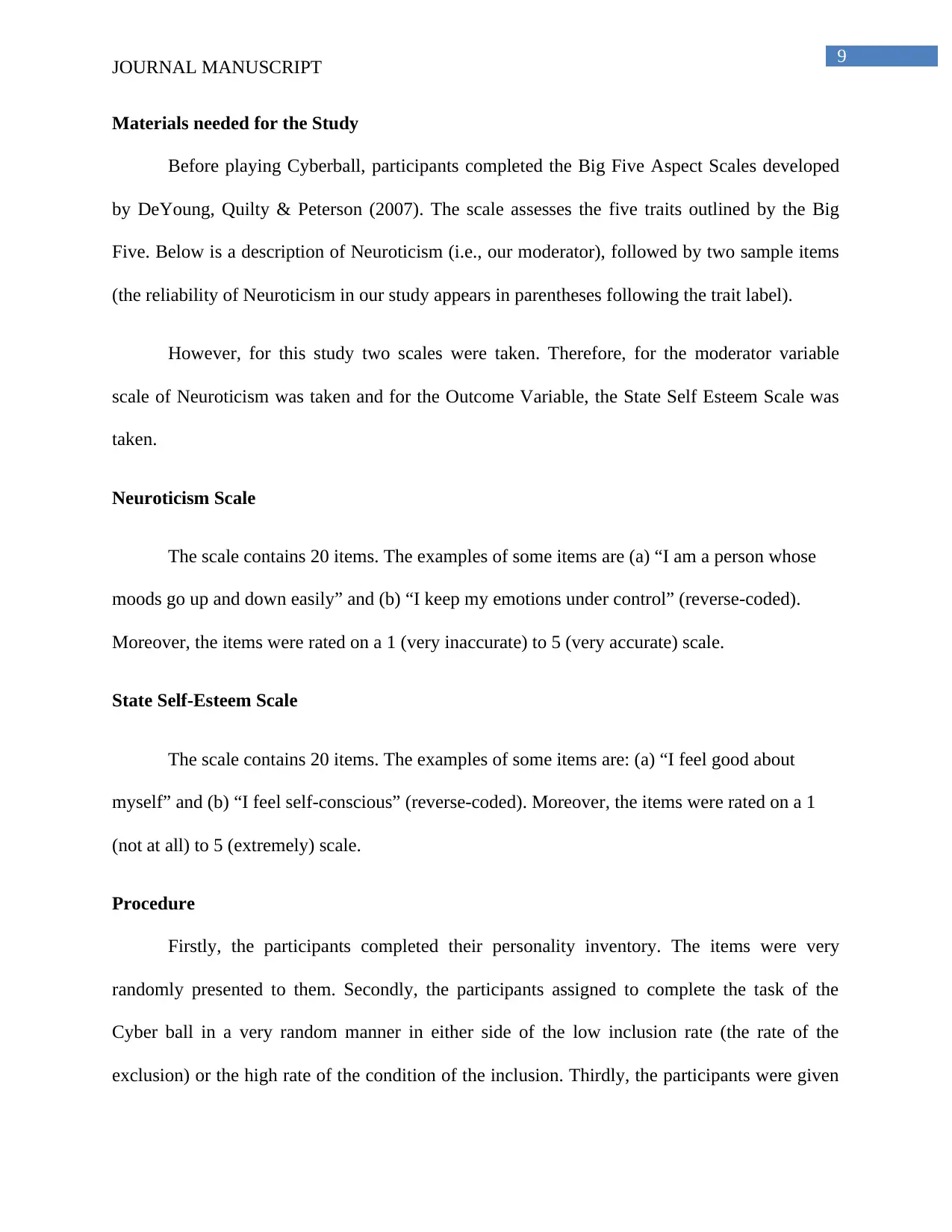
JOURNAL MANUSCRIPT
Materials needed for the Study
Before playing Cyberball, participants completed the Big Five Aspect Scales developed
by DeYoung, Quilty & Peterson (2007). The scale assesses the five traits outlined by the Big
Five. Below is a description of Neuroticism (i.e., our moderator), followed by two sample items
(the reliability of Neuroticism in our study appears in parentheses following the trait label).
However, for this study two scales were taken. Therefore, for the moderator variable
scale of Neuroticism was taken and for the Outcome Variable, the State Self Esteem Scale was
taken.
Neuroticism Scale
The scale contains 20 items. The examples of some items are (a) “I am a person whose
moods go up and down easily” and (b) “I keep my emotions under control” (reverse-coded).
Moreover, the items were rated on a 1 (very inaccurate) to 5 (very accurate) scale.
State Self-Esteem Scale
The scale contains 20 items. The examples of some items are: (a) “I feel good about
myself” and (b) “I feel self-conscious” (reverse-coded). Moreover, the items were rated on a 1
(not at all) to 5 (extremely) scale.
Procedure
Firstly, the participants completed their personality inventory. The items were very
randomly presented to them. Secondly, the participants assigned to complete the task of the
Cyber ball in a very random manner in either side of the low inclusion rate (the rate of the
exclusion) or the high rate of the condition of the inclusion. Thirdly, the participants were given
Paraphrase This Document

JOURNAL MANUSCRIPT
the set of the scales that have included the variable that are dependent. Lastly, the participants
after completing their demographic questionnaire, they were being very carefully debriefed by
the experimenter. Therefore, the whole study was been conducted for approximately 40 minutes.
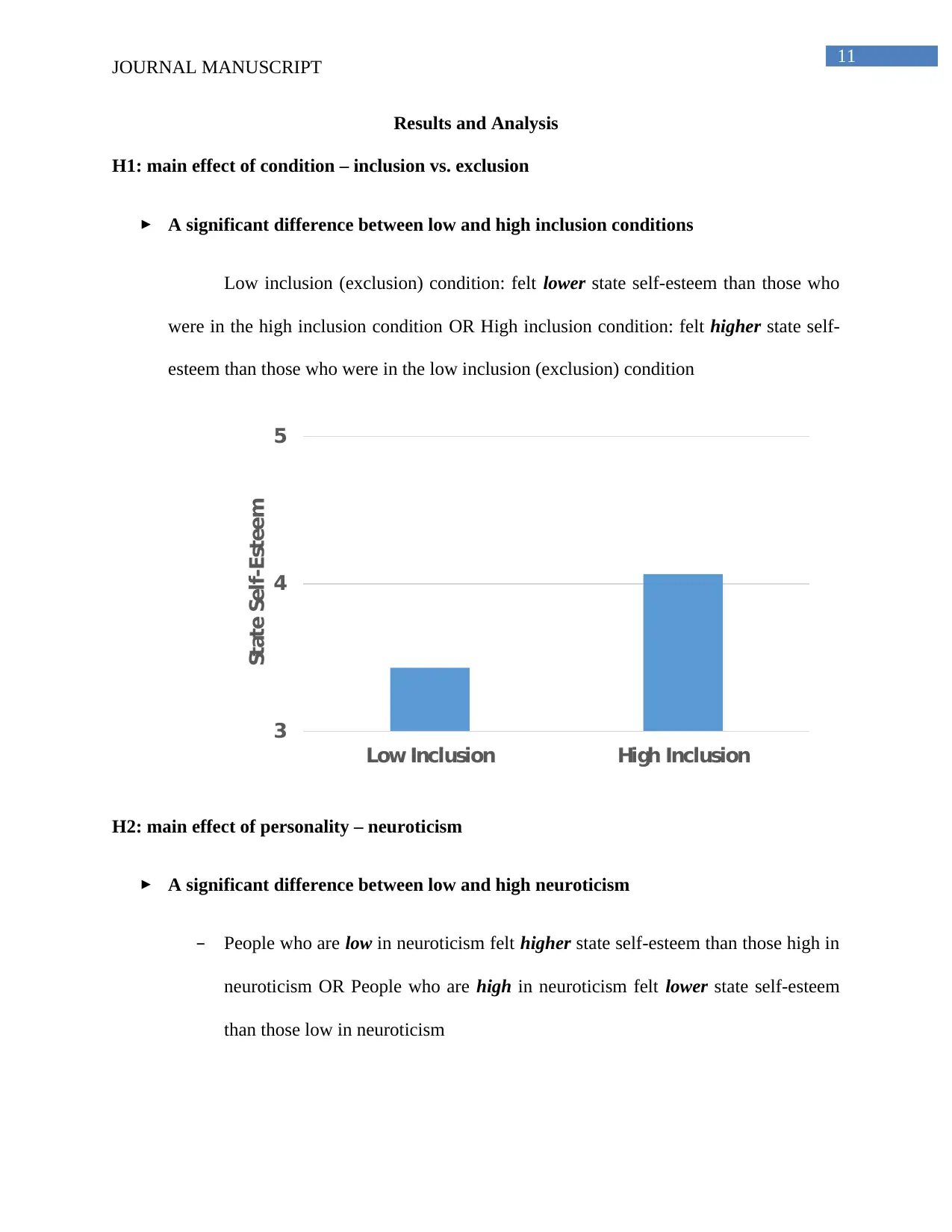
JOURNAL MANUSCRIPT
Results and Analysis
H1: main effect of condition – inclusion vs. exclusion
A significant difference between low and high inclusion conditions
Low inclusion (exclusion) condition: felt lower state self-esteem than those who
were in the high inclusion condition OR High inclusion condition: felt higher state self-
esteem than those who were in the low inclusion (exclusion) condition
3
4
5
Low Inclusion High Inclusion
State Self-Esteem
H2: main effect of personality – neuroticism
A significant difference between low and high neuroticism
– People who are low in neuroticism felt higher state self-esteem than those high in
neuroticism OR People who are high in neuroticism felt lower state self-esteem
than those low in neuroticism
⊘ This is a preview!⊘
Do you want full access?
Subscribe today to unlock all pages.

Trusted by 1+ million students worldwide
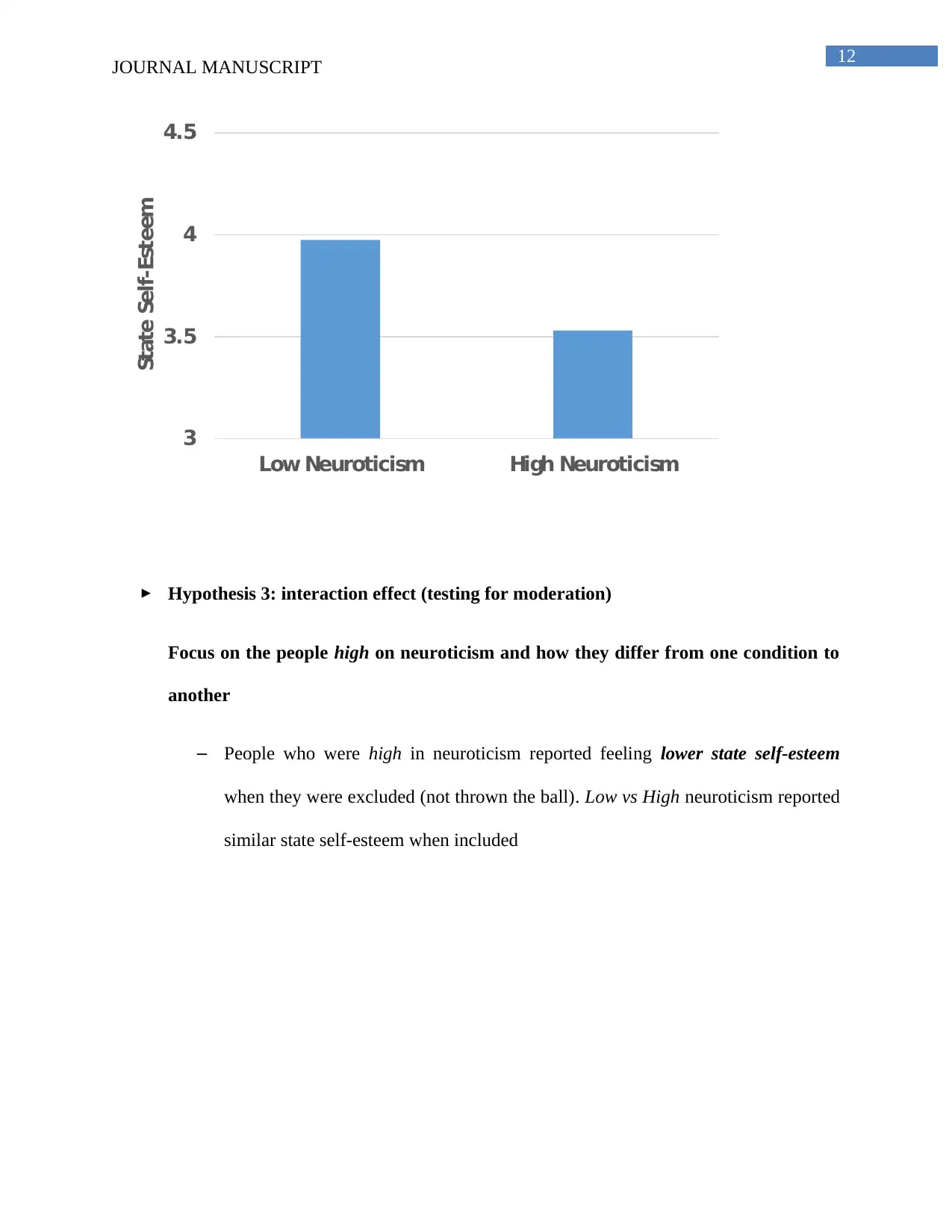
JOURNAL MANUSCRIPT
3
3.5
4
4.5
Low Neuroticism High Neuroticism
State Self-Esteem
Hypothesis 3: interaction effect (testing for moderation)
Focus on the people high on neuroticism and how they differ from one condition to
another
‒ People who were high in neuroticism reported feeling lower state self-esteem
when they were excluded (not thrown the ball). Low vs High neuroticism reported
similar state self-esteem when included
Paraphrase This Document
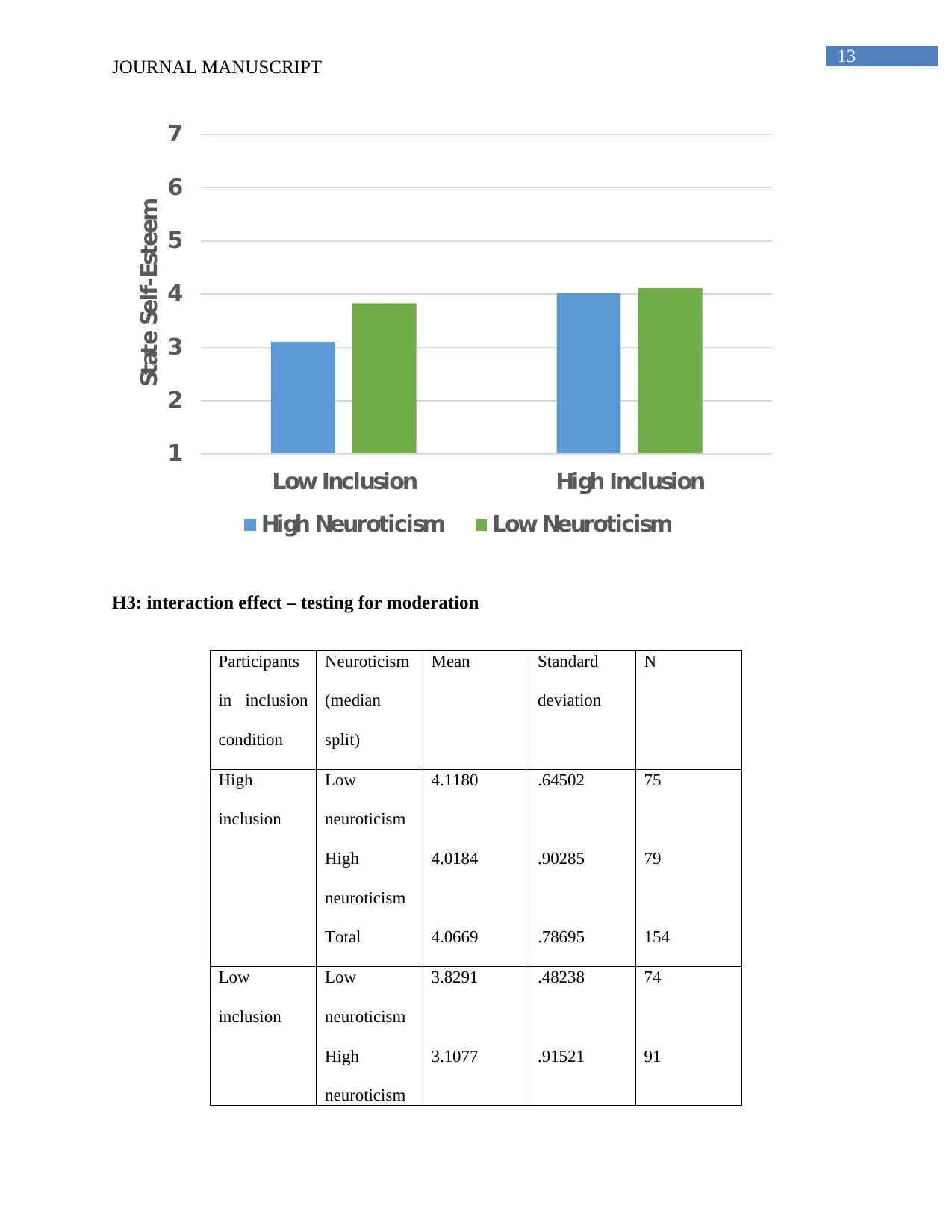
JOURNAL MANUSCRIPT
1
2
3
4
5
6
7
Low Inclusion High Inclusion
State Self-Esteem
High Neuroticism Low Neuroticism
H3: interaction effect – testing for moderation
Participants
in inclusion
condition
Neuroticism
(median
split)
Mean Standard
deviation
N
High
inclusion
Low
neuroticism
High
neuroticism
Total
4.1180
4.0184
4.0669
.64502
.90285
.78695
75
79
154
Low
inclusion
Low
neuroticism
High
neuroticism
3.8291
3.1077
.48238
.91521
74
91
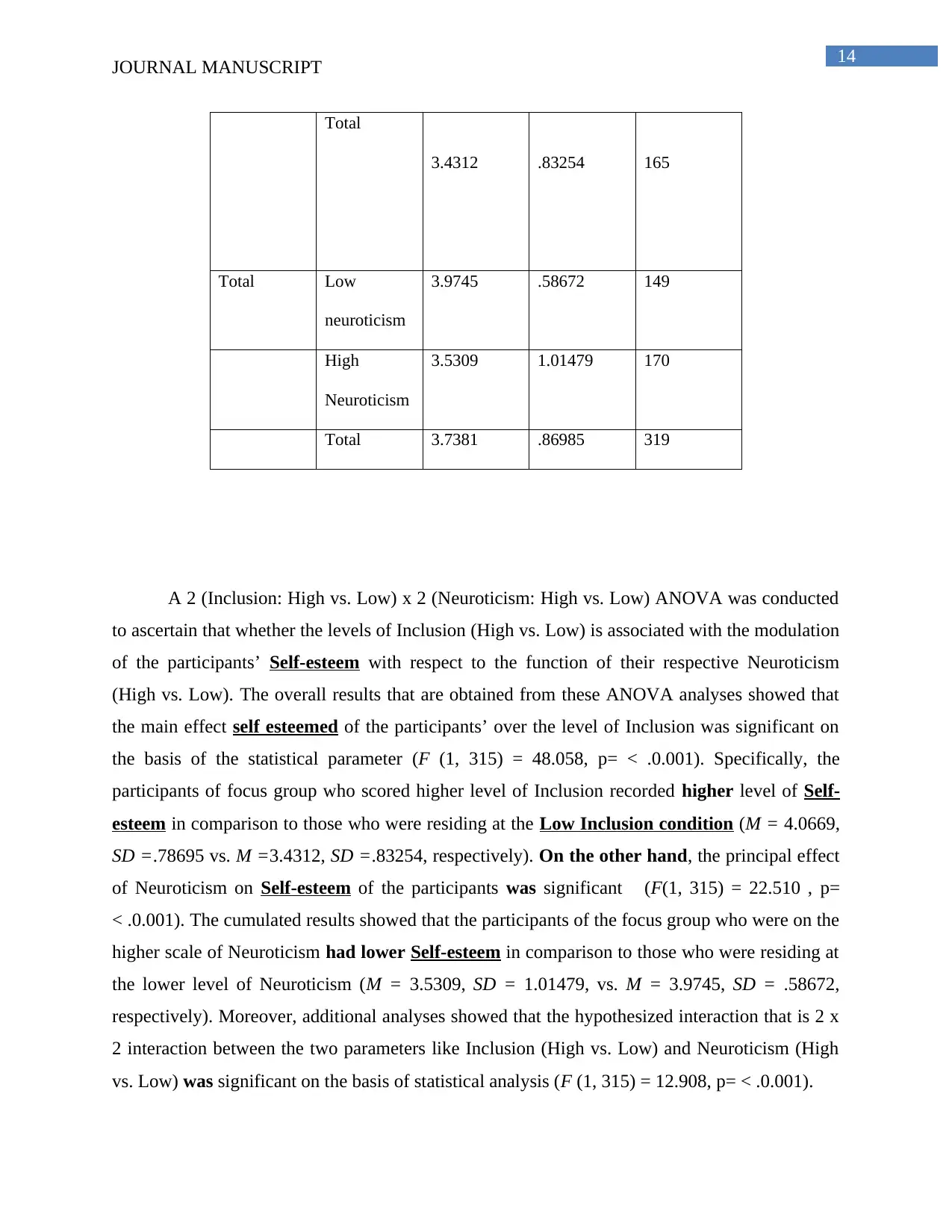
JOURNAL MANUSCRIPT
Total
3.4312 .83254 165
Total Low
neuroticism
3.9745 .58672 149
High
Neuroticism
3.5309 1.01479 170
Total 3.7381 .86985 319
A 2 (Inclusion: High vs. Low) x 2 (Neuroticism: High vs. Low) ANOVA was conducted
to ascertain that whether the levels of Inclusion (High vs. Low) is associated with the modulation
of the participants’ Self-esteem with respect to the function of their respective Neuroticism
(High vs. Low). The overall results that are obtained from these ANOVA analyses showed that
the main effect self esteemed of the participants’ over the level of Inclusion was significant on
the basis of the statistical parameter (F (1, 315) = 48.058, p= < .0.001). Specifically, the
participants of focus group who scored higher level of Inclusion recorded higher level of Self-
esteem in comparison to those who were residing at the Low Inclusion condition (M = 4.0669,
SD =.78695 vs. M =3.4312, SD =.83254, respectively). On the other hand, the principal effect
of Neuroticism on Self-esteem of the participants was significant (F(1, 315) = 22.510 , p=
< .0.001). The cumulated results showed that the participants of the focus group who were on the
higher scale of Neuroticism had lower Self-esteem in comparison to those who were residing at
the lower level of Neuroticism (M = 3.5309, SD = 1.01479, vs. M = 3.9745, SD = .58672,
respectively). Moreover, additional analyses showed that the hypothesized interaction that is 2 x
2 interaction between the two parameters like Inclusion (High vs. Low) and Neuroticism (High
vs. Low) was significant on the basis of statistical analysis (F (1, 315) = 12.908, p= < .0.001).
⊘ This is a preview!⊘
Do you want full access?
Subscribe today to unlock all pages.

Trusted by 1+ million students worldwide
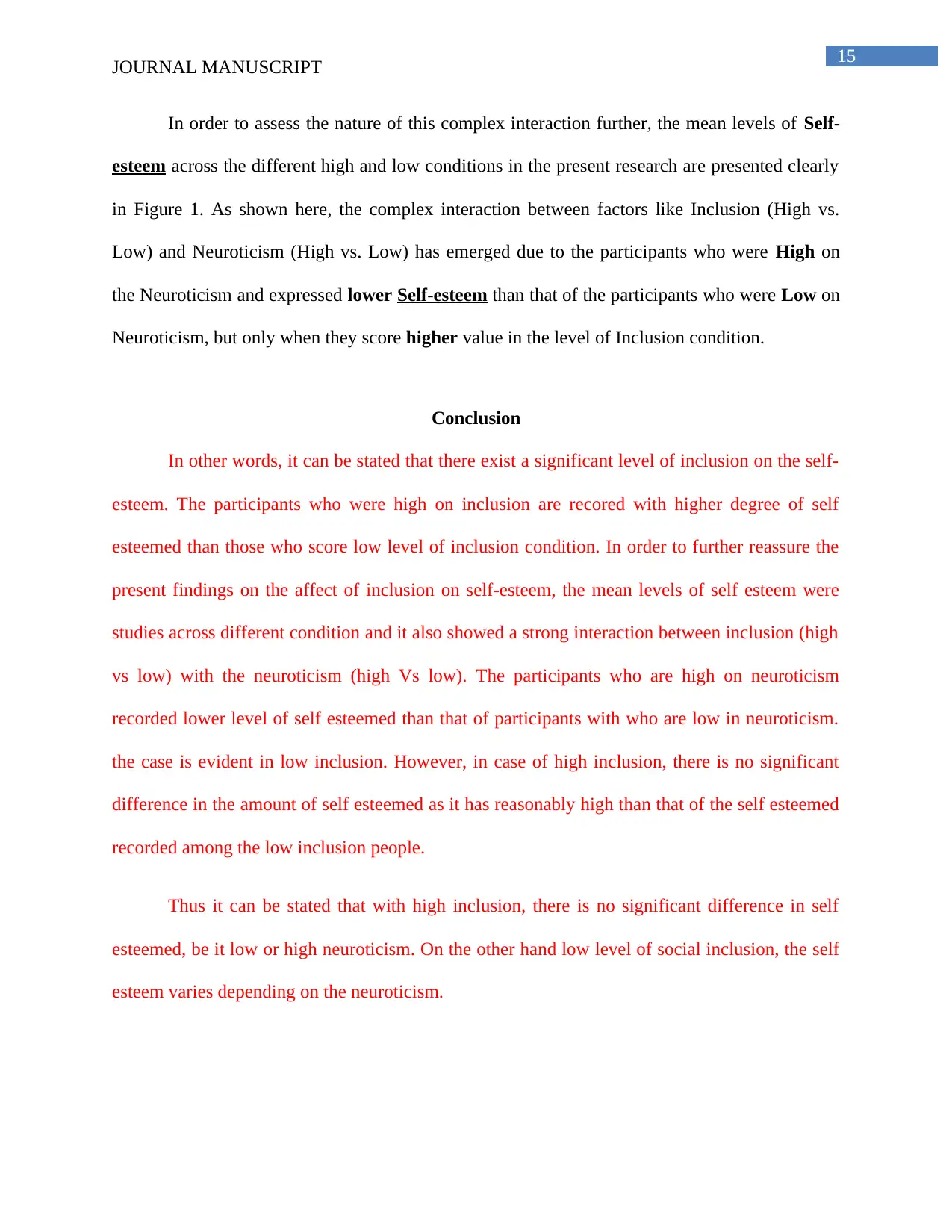
JOURNAL MANUSCRIPT
In order to assess the nature of this complex interaction further, the mean levels of Self-
esteem across the different high and low conditions in the present research are presented clearly
in Figure 1. As shown here, the complex interaction between factors like Inclusion (High vs.
Low) and Neuroticism (High vs. Low) has emerged due to the participants who were High on
the Neuroticism and expressed lower Self-esteem than that of the participants who were Low on
Neuroticism, but only when they score higher value in the level of Inclusion condition.
Conclusion
In other words, it can be stated that there exist a significant level of inclusion on the self-
esteem. The participants who were high on inclusion are recored with higher degree of self
esteemed than those who score low level of inclusion condition. In order to further reassure the
present findings on the affect of inclusion on self-esteem, the mean levels of self esteem were
studies across different condition and it also showed a strong interaction between inclusion (high
vs low) with the neuroticism (high Vs low). The participants who are high on neuroticism
recorded lower level of self esteemed than that of participants with who are low in neuroticism.
the case is evident in low inclusion. However, in case of high inclusion, there is no significant
difference in the amount of self esteemed as it has reasonably high than that of the self esteemed
recorded among the low inclusion people.
Thus it can be stated that with high inclusion, there is no significant difference in self
esteemed, be it low or high neuroticism. On the other hand low level of social inclusion, the self
esteem varies depending on the neuroticism.
Paraphrase This Document
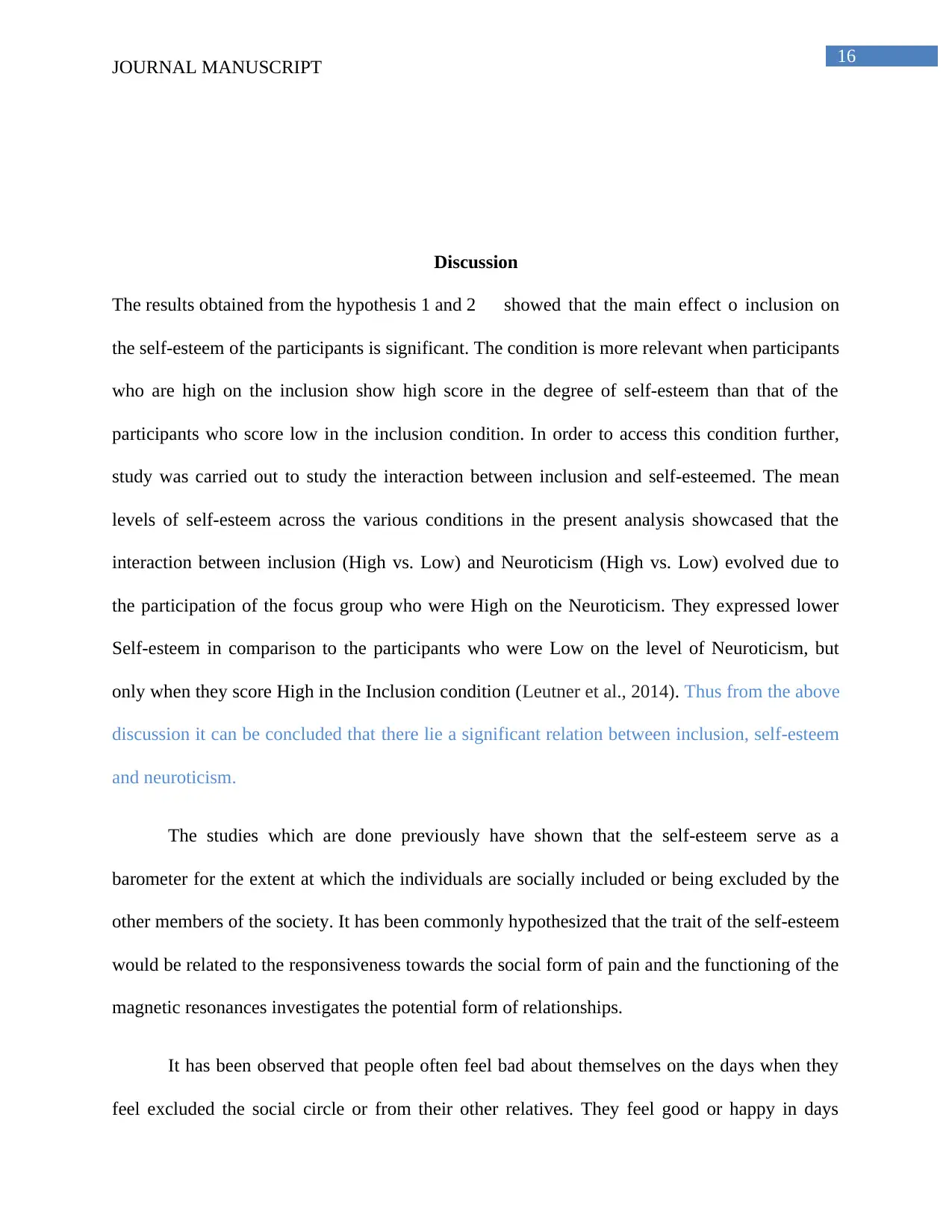
JOURNAL MANUSCRIPT
Discussion
The results obtained from the hypothesis 1 and 2 showed that the main effect o inclusion on
the self-esteem of the participants is significant. The condition is more relevant when participants
who are high on the inclusion show high score in the degree of self-esteem than that of the
participants who score low in the inclusion condition. In order to access this condition further,
study was carried out to study the interaction between inclusion and self-esteemed. The mean
levels of self-esteem across the various conditions in the present analysis showcased that the
interaction between inclusion (High vs. Low) and Neuroticism (High vs. Low) evolved due to
the participation of the focus group who were High on the Neuroticism. They expressed lower
Self-esteem in comparison to the participants who were Low on the level of Neuroticism, but
only when they score High in the Inclusion condition (Leutner et al., 2014). Thus from the above
discussion it can be concluded that there lie a significant relation between inclusion, self-esteem
and neuroticism.
The studies which are done previously have shown that the self-esteem serve as a
barometer for the extent at which the individuals are socially included or being excluded by the
other members of the society. It has been commonly hypothesized that the trait of the self-esteem
would be related to the responsiveness towards the social form of pain and the functioning of the
magnetic resonances investigates the potential form of relationships.
It has been observed that people often feel bad about themselves on the days when they
feel excluded the social circle or from their other relatives. They feel good or happy in days
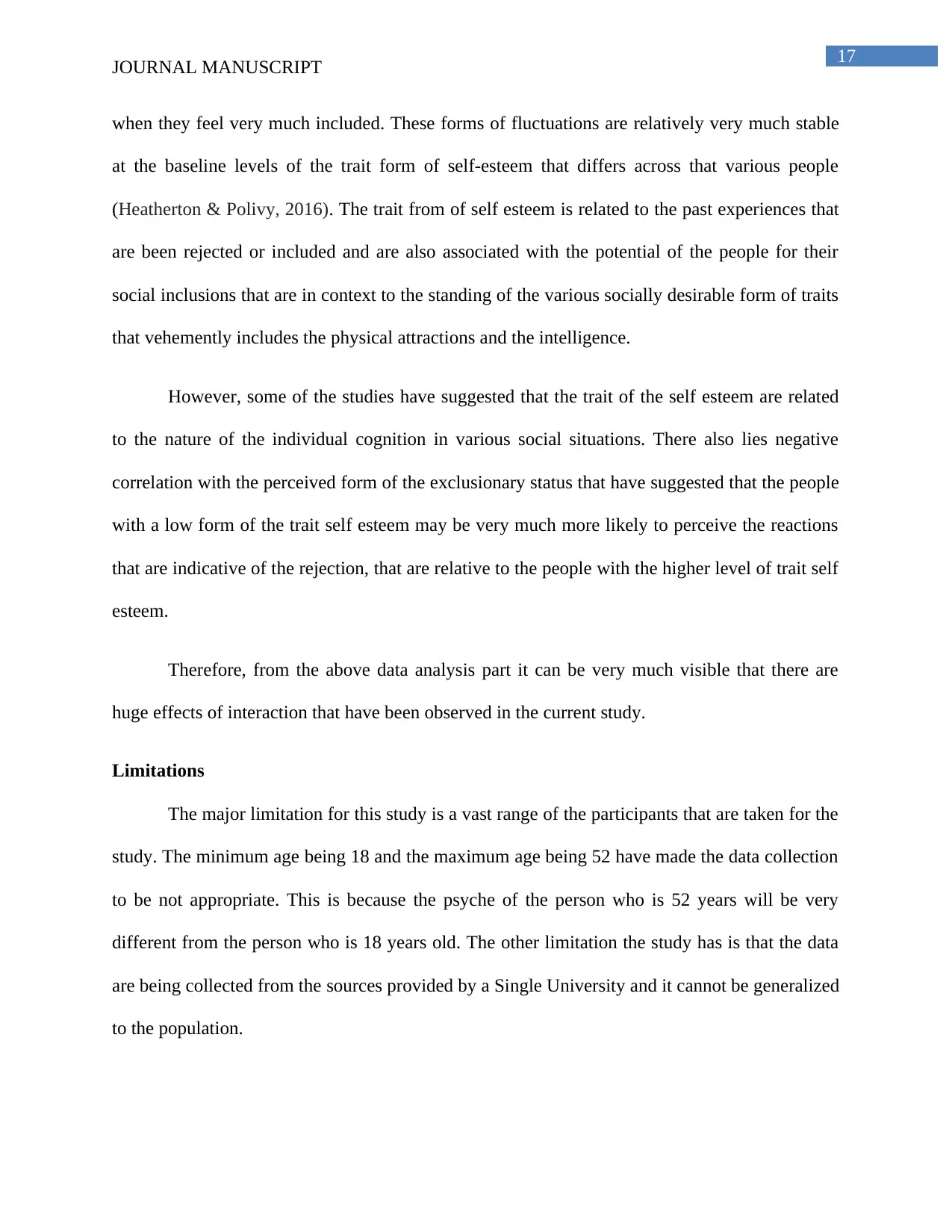
JOURNAL MANUSCRIPT
when they feel very much included. These forms of fluctuations are relatively very much stable
at the baseline levels of the trait form of self-esteem that differs across that various people
(Heatherton & Polivy, 2016). The trait from of self esteem is related to the past experiences that
are been rejected or included and are also associated with the potential of the people for their
social inclusions that are in context to the standing of the various socially desirable form of traits
that vehemently includes the physical attractions and the intelligence.
However, some of the studies have suggested that the trait of the self esteem are related
to the nature of the individual cognition in various social situations. There also lies negative
correlation with the perceived form of the exclusionary status that have suggested that the people
with a low form of the trait self esteem may be very much more likely to perceive the reactions
that are indicative of the rejection, that are relative to the people with the higher level of trait self
esteem.
Therefore, from the above data analysis part it can be very much visible that there are
huge effects of interaction that have been observed in the current study.
Limitations
The major limitation for this study is a vast range of the participants that are taken for the
study. The minimum age being 18 and the maximum age being 52 have made the data collection
to be not appropriate. This is because the psyche of the person who is 52 years will be very
different from the person who is 18 years old. The other limitation the study has is that the data
are being collected from the sources provided by a Single University and it cannot be generalized
to the population.
⊘ This is a preview!⊘
Do you want full access?
Subscribe today to unlock all pages.

Trusted by 1+ million students worldwide
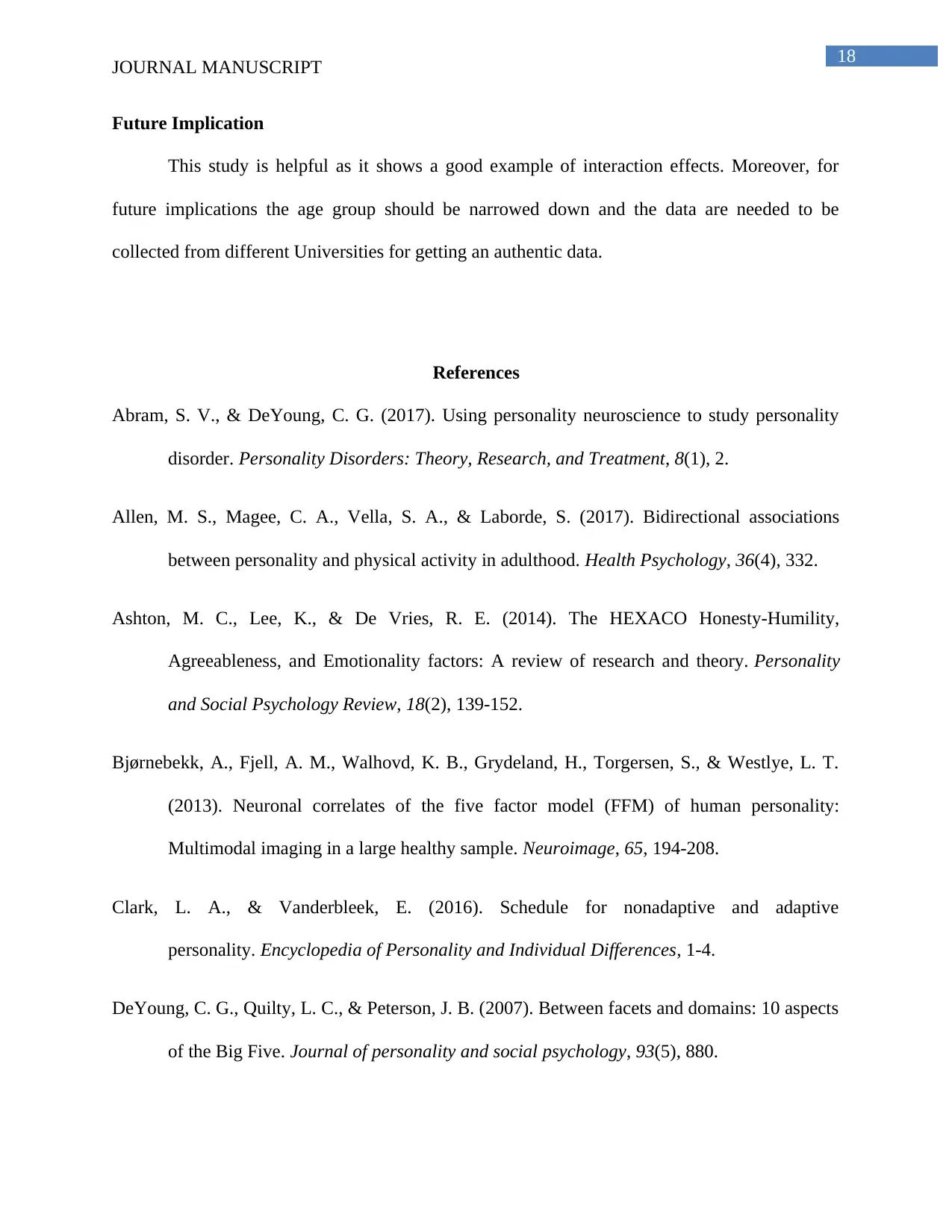
JOURNAL MANUSCRIPT
Future Implication
This study is helpful as it shows a good example of interaction effects. Moreover, for
future implications the age group should be narrowed down and the data are needed to be
collected from different Universities for getting an authentic data.
References
Abram, S. V., & DeYoung, C. G. (2017). Using personality neuroscience to study personality
disorder. Personality Disorders: Theory, Research, and Treatment, 8(1), 2.
Allen, M. S., Magee, C. A., Vella, S. A., & Laborde, S. (2017). Bidirectional associations
between personality and physical activity in adulthood. Health Psychology, 36(4), 332.
Ashton, M. C., Lee, K., & De Vries, R. E. (2014). The HEXACO Honesty-Humility,
Agreeableness, and Emotionality factors: A review of research and theory. Personality
and Social Psychology Review, 18(2), 139-152.
Bjørnebekk, A., Fjell, A. M., Walhovd, K. B., Grydeland, H., Torgersen, S., & Westlye, L. T.
(2013). Neuronal correlates of the five factor model (FFM) of human personality:
Multimodal imaging in a large healthy sample. Neuroimage, 65, 194-208.
Clark, L. A., & Vanderbleek, E. (2016). Schedule for nonadaptive and adaptive
personality. Encyclopedia of Personality and Individual Differences, 1-4.
DeYoung, C. G., Quilty, L. C., & Peterson, J. B. (2007). Between facets and domains: 10 aspects
of the Big Five. Journal of personality and social psychology, 93(5), 880.
Paraphrase This Document
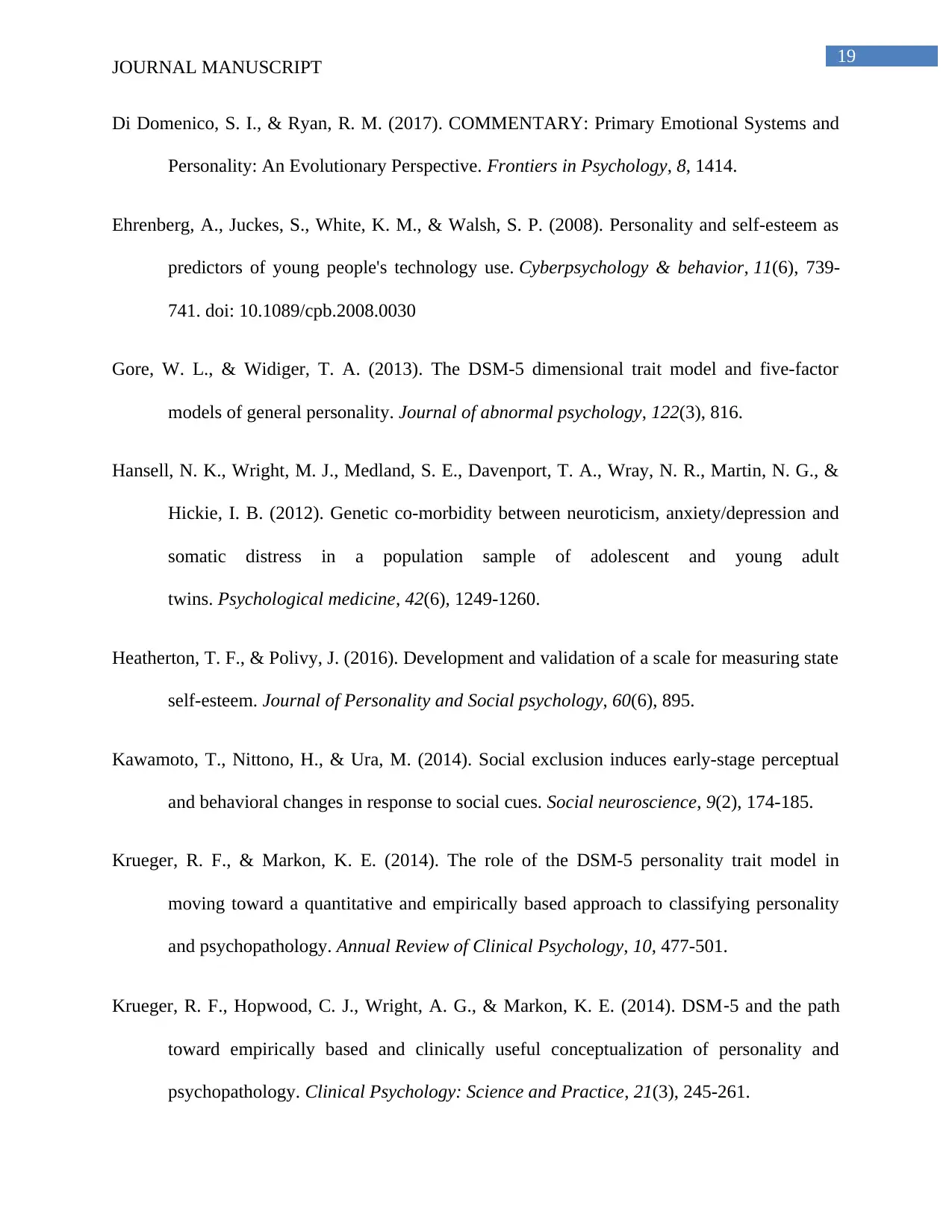
JOURNAL MANUSCRIPT
Di Domenico, S. I., & Ryan, R. M. (2017). COMMENTARY: Primary Emotional Systems and
Personality: An Evolutionary Perspective. Frontiers in Psychology, 8, 1414.
Ehrenberg, A., Juckes, S., White, K. M., & Walsh, S. P. (2008). Personality and self-esteem as
predictors of young people's technology use. Cyberpsychology & behavior, 11(6), 739-
741. doi: 10.1089/cpb.2008.0030
Gore, W. L., & Widiger, T. A. (2013). The DSM-5 dimensional trait model and five-factor
models of general personality. Journal of abnormal psychology, 122(3), 816.
Hansell, N. K., Wright, M. J., Medland, S. E., Davenport, T. A., Wray, N. R., Martin, N. G., &
Hickie, I. B. (2012). Genetic co-morbidity between neuroticism, anxiety/depression and
somatic distress in a population sample of adolescent and young adult
twins. Psychological medicine, 42(6), 1249-1260.
Heatherton, T. F., & Polivy, J. (2016). Development and validation of a scale for measuring state
self-esteem. Journal of Personality and Social psychology, 60(6), 895.
Kawamoto, T., Nittono, H., & Ura, M. (2014). Social exclusion induces early-stage perceptual
and behavioral changes in response to social cues. Social neuroscience, 9(2), 174-185.
Krueger, R. F., & Markon, K. E. (2014). The role of the DSM-5 personality trait model in
moving toward a quantitative and empirically based approach to classifying personality
and psychopathology. Annual Review of Clinical Psychology, 10, 477-501.
Krueger, R. F., Hopwood, C. J., Wright, A. G., & Markon, K. E. (2014). DSM‐5 and the path
toward empirically based and clinically useful conceptualization of personality and
psychopathology. Clinical Psychology: Science and Practice, 21(3), 245-261.
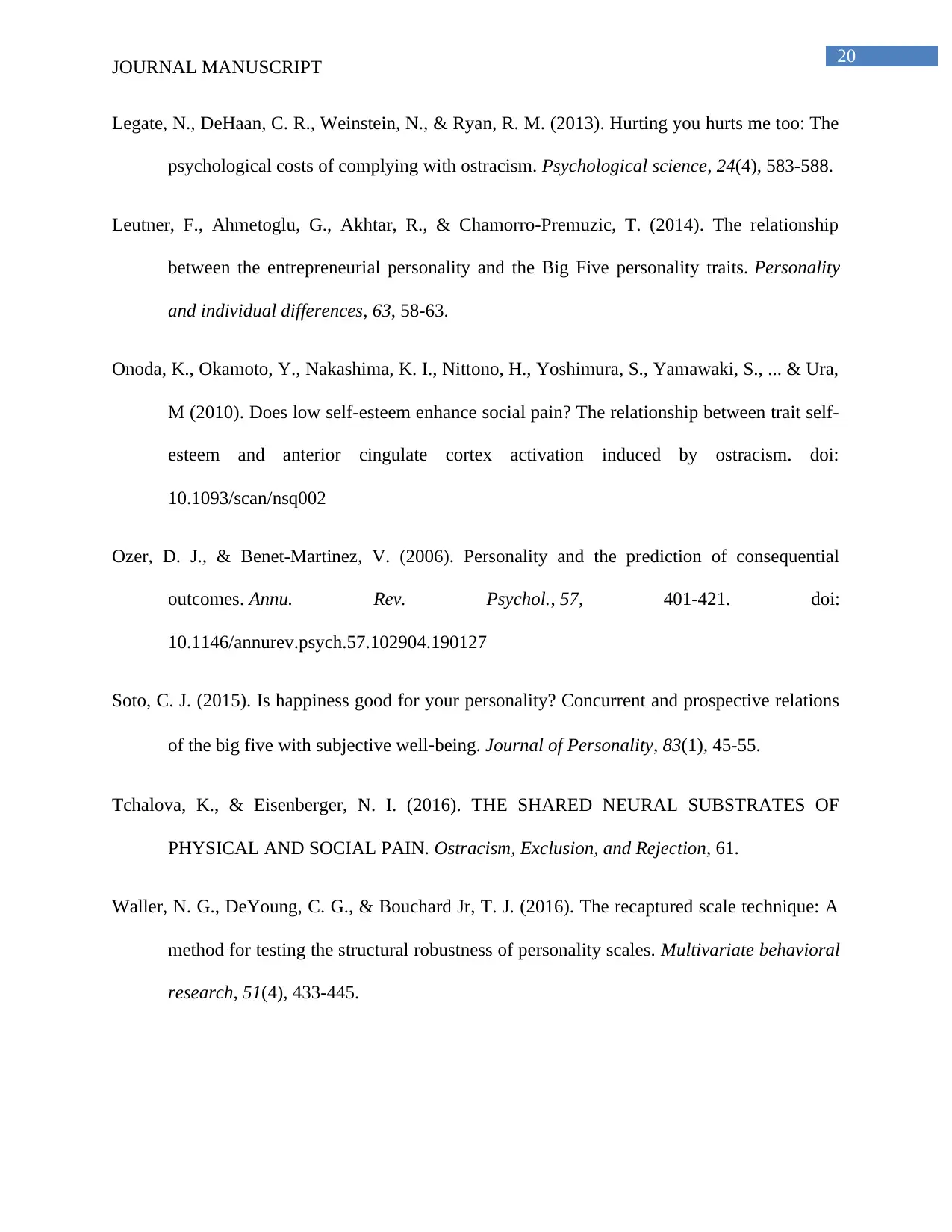
JOURNAL MANUSCRIPT
Legate, N., DeHaan, C. R., Weinstein, N., & Ryan, R. M. (2013). Hurting you hurts me too: The
psychological costs of complying with ostracism. Psychological science, 24(4), 583-588.
Leutner, F., Ahmetoglu, G., Akhtar, R., & Chamorro-Premuzic, T. (2014). The relationship
between the entrepreneurial personality and the Big Five personality traits. Personality
and individual differences, 63, 58-63.
Onoda, K., Okamoto, Y., Nakashima, K. I., Nittono, H., Yoshimura, S., Yamawaki, S., ... & Ura,
M (2010). Does low self-esteem enhance social pain? The relationship between trait self-
esteem and anterior cingulate cortex activation induced by ostracism. doi:
10.1093/scan/nsq002
Ozer, D. J., & Benet-Martinez, V. (2006). Personality and the prediction of consequential
outcomes. Annu. Rev. Psychol., 57, 401-421. doi:
10.1146/annurev.psych.57.102904.190127
Soto, C. J. (2015). Is happiness good for your personality? Concurrent and prospective relations
of the big five with subjective well‐being. Journal of Personality, 83(1), 45-55.
Tchalova, K., & Eisenberger, N. I. (2016). THE SHARED NEURAL SUBSTRATES OF
PHYSICAL AND SOCIAL PAIN. Ostracism, Exclusion, and Rejection, 61.
Waller, N. G., DeYoung, C. G., & Bouchard Jr, T. J. (2016). The recaptured scale technique: A
method for testing the structural robustness of personality scales. Multivariate behavioral
research, 51(4), 433-445.
⊘ This is a preview!⊘
Do you want full access?
Subscribe today to unlock all pages.

Trusted by 1+ million students worldwide
Your All-in-One AI-Powered Toolkit for Academic Success.
+13062052269
info@desklib.com
Available 24*7 on WhatsApp / Email
![[object Object]](/_next/static/media/star-bottom.7253800d.svg)
© 2024 | Zucol Services PVT LTD | All rights reserved.
